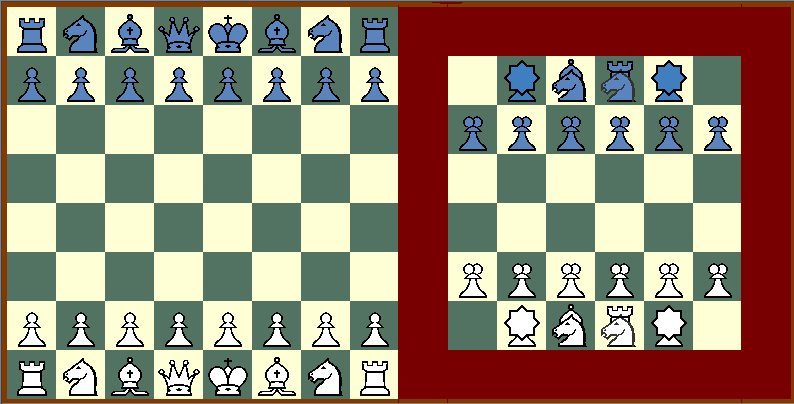
I am not a big fan of Grand Chess.
I also fail to understand why the Marshall and the Cardinal should be more legitimate alternatives to the Queen than the Berolina Pawn is to the Pawn.
There is another reason for my dislike of Grand Chess or Capablanca Chess. I wish to save a big chunk of Chess opening theory. Unfortunately, simply keeping the usual pieces on a 8x8 portion within a larger 8x10, 8x12 or 10x10 structure doesn't do the job, regardless of the new pieces. For instance, my own Chess on a Larger Board with not so few pieces dropped may start 1.e4 e5 2.Nf3 Nc6 3.Bb5... just to allow my brand of Murray Lion to jump on a6 and chase the Bishop away, so there is no Ruy Lopez. If I want to play the Pirc Defence at Jean-Louis Cazaux's Shako, it goes (let's assume that the Kings are on e1 and e8) 1.e4 d6 2.d4 Nf6, only to have White protect the Pawn on e4 with a Cannon instead of having to play Nc3 or f3. Such misfortune would happen also on David Paulowich's MRNBQKBNRM or George Duke's FRNBQKBNRF 10x8 Chancellor and Falcon arrays. The extra pieces shouldn't be able to reach the original setup in less than two or three moves.

|
|
The Marshall and the Cardinal move as they do in Grand Chess, that is, as
a Rook or a Knight and as a Bishop or a Knight.
(Like the Knight, they may jump over a non-existent square, but
the Cardinal isn't permitted the above commuting Bishop move.)
The Berolina Pawn moves without capturing one square diagonally forward and captures one square orthogonally forward. Since it is restricted to (a part of) a 36-square zone, there is no double-step move. Like the Pawn, it may only promote to a Rook, a Bishop, a Knight or a Pawn of Camel. (Of course, a Rook won't be able to leave the secondary board.)
The Guard is a soon-to-be Wazir or Firz.
(The Wazir and the Firz respectively move one square
orthogonally and one square diagonally.)
It moves (and captures) like a King. but becomes a Firz or a Wazir as soon as
any Guard moves.
When a player moves a Guard orthogonally, both his Guards become Wazirs
and both his opponent's Guards become Firzes (assuming no Guard has been
captured, of course), but his opponent is allowed to turn immediately
his Firzes into Wazirs. (This also counts as a move.). Conversely, when
a player moves a Guard diagonally, both his Guards become Firzes and both
his opponent's Guards become Wazirs, and the opponent is allowed to turn
them immediately into Firzes.
The Camel is a colorbound leaper: it moves three squares in one
direction and one square in another. Like the Knight and its
compounds, it may jump between the main board and the secondary board.
The Pawn of Camel can't move, and is allowed only two actions:
It may promote to a Camel, and it may commit suicide while turning
an enemy Marshall or Cardinal into a Camel.
There are roughly three kind of pieces: the usual array, the pieces of secondary interest (the Marshall, the Cardinal, the Berolina Pawn and perhaps the Camel) and the pieces which have been added as tuners.
The Marshall and the Cardinal are significantly weaker than the Queen, since they are several moves away from the King and run the risk of being turned into Camels. On the cramped secondary board, there is often a (not that) premature exchange of Cardinals and/or Marshalls.
The Guards are particularly useful.
The Pawn of Camel is also a bit contrived. But if a Berolina Pawn could turn a Marshall or a Cardinal into a Camel regardless of being capturable on its promotion row, it would be too easy in my view. Conversely, if a Pawn reached its promotion row on a square where it couldn't be captured, the enemy Marshall or Cardinal would suicide itself at once on a Rook, Bishop or even Knight (maybe after moving at a Camel's leap of the Pawn owner's King or other piece), since a Camel is weaker than any of them, and the game would see no Camel at all.
The opening should be quite akin to the opening theory of Chess,
although the game is more dynamic. Debatable gambit openings
should become sounder, either scoring a quick win or
backfiring less definitively as usual.
(Of course, there still are differences. For instance, a Knight
on the a or h file becomes more useful.)
There are two kinds of middle games. One features the same number of composed pieces (Queen, Marshall and Cardinal) for each player on both boards and is nearly as strategic as Chess (and certainly more strategic than Grand Chess or Capablanca Chess), the other is a race between mate on the main board and (immediately rewarding) demotions and (less immediately rewarding) promotions on the secondary board.
The endgame belongs to the Rooks, the Bishops and the Knights, since the Berolina Pawns are seldom promoted into Rooks.